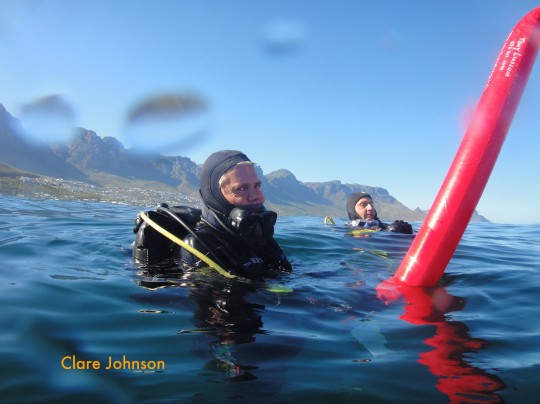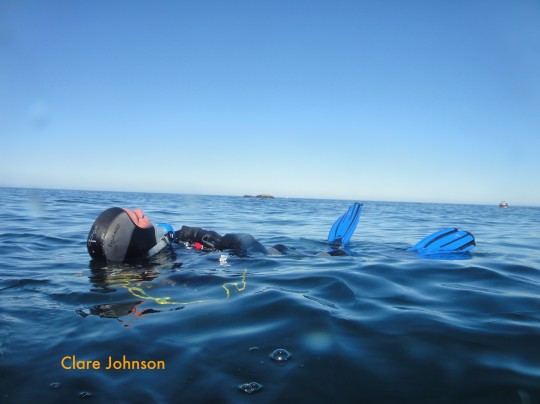Tony has dived North Paw before (while I sat, sick with jealousy, in front of an Excel spreadsheet at work). This time I went with him and some students, and we were to explore an unmapped pinnacle to the north of the site, which seems to be quite extensive. It rises to within 10-12 metres of the surface, and doesn’t actually have a name yet…

Grant’s best suggestion (which some on the boat were keen to override) is “Bokkie’s Rump” – the idea being that the lion (Lion’s head) has its two paws (North Lion’s Paw and South Lion’s Paw) resting on a little springbok that he’s caught. The bokkie’s rump (ahem) sticks out beyond the northern paw.

Grant put the shot on top of the pinnacle, which according to Peter Southwood, is about 8 by 10 metres. We descended next to it – a lovely sheer wall – down to the sand at about 20 metres. There are rock lobsters galore, and rich invertebrate life.

Georgina pointed out a large cuttlefish, well camouflaged on the reef. When he moved, he changed colour to match his new background. Tony also found four tiny cuttlefish – fingernail-sized – lined up as if for a race. When he turned to call me with the camera, they scattered, invisibly, on the sand.


I found a few different nudibranchs – black, gas flame and crowned – and Tony also found one for me, much to his delight. He claims to have been having a “nudibranch drought” lately!


The site is rocky with lots of crevices for rock lobster to hide in. We saw some large ones, but, Gerard assured me, no HUGE ones. He should know! We were highly amused to see one big guy eating a sea jelly – the ocean floor was littered with a few dead (or incapacitated) ones, and apparently rock lobsters enjoy that kind of treat. I also saw a large rock lobster carefully carrying a cluster of mussels!

At the safety stop I saw no fewer than four different kinds of sea jelly – the largest being a night light sea jelly that was almost as long as Tony, with a huge purple bell. He obligingly swam behind it to give some perspective to the photo but I carried on photographing the jelly as it swam off into the distance.

Gerard had gotten low on air earlier, and returned to the boat… While he was waiting for a pick-up, something bumped his leg hard, and he was convinced it was a shark. Instead, it was one of the friendly seals that had visited us during our dive. His comments on the subject are unprintable – suffice it to say he got a bit of a fright!

When the rest of us surfaced we got to chill for a while, looking at the magnificent scenery, because we’d come quite far from the original pinnacle. We had drifted with the current, roughly towards the Atlantic seaboard. It must be – as I announced when the boat arrived – the most beautiful place in the world to surface. The diving’s pretty good too!

Dive date: 20 February 2011
Air temperature: 27 degrees
Water temperature: 8 degrees
Maximum depth: 23.6 metres
Visibility: 10 metres
Dive duration: 36 minutes









Comments are closed.